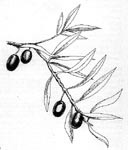The olive (which most common species has the scientific name “OLEA EUROPEA L.”) mainly comes from the Mediterranean areas (Morocco, Spain and Greece). It can be also found in various areas of Asia, America and Oceania. Traces of cores of olive-trees were dated with Carbon-14 of more than 8000 years, whereas we have traces of the culture of the olive-tree in Crete 2500 years before our era.

The calming and curative virtues of the olive oil are apparently at the origin of the symbol of peace, which has the branch of the olive-tree. The olive-tree is present in our culture since many centuries, as in the Bible where the Gabriel angel offered a branch of it to Adam, in order to let him plant it and enjoy its oil, or in Greek mythology where it is the gift of Athena to humanity.
The olive tree is also famous for its longevity. Some olive-trees are more than 2000 years old and can reach a height of 15 meters for a scale of 10 meters.
In Morocco, olive-tree is considered as the palm tree. Some studies estimate that it covers a surface from 400,000 to 500,000 hectares distributed on all the territory.
Moroccan olives can be used for triturating and table consumption. All the standard calibers are available.
The most common preparations are green olives in brine, olives darkened by oxidation, black olives Greek Style and the natural olives.
The types of olives that are mainly produced in Morocco are the “Beldis”, equivalent to Spanish Manzanilla. The calibers are measured by the average number of fruits by 100 grams. For example, between 22 and 25 olives are needed to make 100 grams of olives 22/25.
The olives are gathered from September to January. At the beginning of the crop, the olives are green, then ripe black at the end of the crop, passing by a phase where their color is brown.
In the natural state, the olive has a very marked bitterness. Generally, the first stage of preparation of table olives is to remove their natural bitterness in a little concentrated soda solution.
The olives of the beginning of the crop, still green, have their bitterness removed, and are then preserved in a brine solution for their fermentation. They can be then consumed in aperitif or with cooked dishes. They are offered whole, pitted or sliced, in barrels or metal tins.
The clearest brown olives come also in drums or tins, whole, gashed or broken.
The darkest natural olives can be blackened by oxidation in tanks made for this purpose. These oxidized black olives are then rinsed and sterilized during their conditioning. They are proposed whole, pitted or sliced, packed in tins.
When they are gathered quite black, they can also be used for the preparation of Greek style olives. After a specific processing, these olives are dehydrated by a long presence in salt. Their wrinkled aspect and taste are unique. Our factories have a long experience in the development of these specialties. We carry them packed in barrels or vacuumed bags of 5 kilos.
In addition, we have developed several olive recipes (based on spices, herbs…) ready to serve. We ask you to contact us for any information.